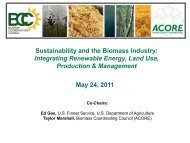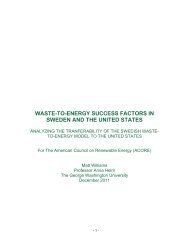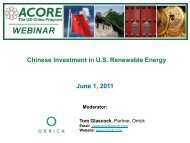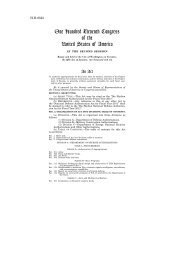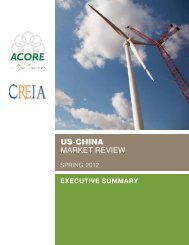<strong>Renewable</strong> <strong>Energy</strong> Economics, Marketplace,and FinanceOverviewBecause RETECH was held just weeks into anew Presidential administration, and amidst thebiggest economic crises in generations,economics were of vital interest at RETECH2009. Discussion regarding various aspects ofthe economy took place in nearly every session,spanning the implications of the <strong>American</strong>Recovery and Reinvestment Act, the state offinancial markets, and the prospect of RPS andcarbon legislation at the national level. Leadersfrom state and national government, finance,and policy convened to discuss how to get therenewable energy economy—and the nationaleconomy—moving once more.ConsensusAt RETECH 2009, there was a sense of optimismregarding renewable energy economics and thefederal government’s commitment to renewableenergy. There was also a humbleacknowledgement of the problems yet to besolved. With a once-in-a-generation stimulusplan sitting astride a once-in-a-generationmarket crisis, hope and uncertainty bothabounded. The innovative action taken byCongress to mobilize renewable energydevelopment as part of the <strong>American</strong> Recoveryand Reinvestment Act presented the industrywith many new opportunities. Theseopportunities were laid out in great detail byRETECH panelists.Economic DriversState <strong>Renewable</strong> Portfolio Standards (RPS) areparamount to systematically increasingrenewable energy generation in the US.The rising, volatile price of fossil fuelgeneratedenergy is the main economicdriver of the renewable energy industry. State<strong>Renewable</strong> Portfolio Standards (RPS) haveplayed and still play a key role in mobilizingrenewable production.<strong>Renewable</strong> Portfolio Standards were born in 1995. Today,28 states have mandatory standards, 16 of them inexcess of 20%, and 6 have voluntary standards,explained panelist Alan Nogee, Director, Union ofConcerned Scientists.Under a business-as-usual scenario, by 2025 thesestandards will yield 77,000 MW of new renewable energy,reducing carbon emissions by 183,000 tons, the equivalentof taking 30 million cars off the road for a year. In thisscenario, renewable energy would mostly displace gasandcoal-fired plants, which Mr. Nogee forecasted wouldbe replaced by 53% wind and 21% solar, with biomassassuming a large role in the early transitional years. <strong>On</strong>top of a 1.6% ($95 billion) consumer savings comparedwith a business-as-usual model by 2030, the world wouldenjoy massive environmental benefits from the switch.With state and federal tax incentives, renewableenergy can be more affordable and competitivewith other energy sources.State and federal subsidies such as the Production andInvestment Tax Credits have provided the short-term costviability of renewable energy options. These credits havebeen extended and are compatible with a credit-constrainedenvironment in the <strong>American</strong> Recovery andReinvestment Act (ARRA). The ARRA extends the ProductionTax Credit (PTC) for Wind to 2012, and all otherrenewables to 2013, explained Eli Katz of Chadbourne &Park. The extension should help guard against the boomand bust cycles renewable energy has suffered during the<strong>American</strong> <strong>Council</strong> <strong>On</strong> <strong>Renewable</strong> <strong>Energy</strong>Executive Summary Report 44
past, uncertain legislative environment. The ARRA alsoextended the Investment Tax Credit (ITC), and expandedits use to wind projects as an alternative to the PTC. Katzforecasted that due to current credit shortages, the ITC/PTC choice will boil down to the option that requires lesscapital on day one.Other factors affecting renewable energy financeand economics include bonus depreciation,cash grant, and manufacturing tax credits.The <strong>American</strong> Recovery and Reinvestment Act alsoextends the 2008 Stimulus Act which grants developers50% of the Bonus Depreciation upon implementation onprojects completed before the end of 2009, with theremainder of the depreciation written off on the normalschedule. A new stimulus package option is the CashGrant program, where the government essentially buys adeveloper’s investment tax credit of 30% of the totalproject cost, another mechanism to decrease the up-frontcapital necessary to develop projects. Lastly, a new 30%Manufacturing Investment Tax Credit is now available forprojects that re-equip or expand manufacturing facilities tofacilitate the production of renewable energy, energy efficiencyand fuel cell technologies.The Department of <strong>Energy</strong>’s role in scaling uprenewable energyThe Department of <strong>Energy</strong> is expected to assume a muchlarger role in the renewable energy project implementationprocess, by granting increased funding with an emphasison the Loan Guarantee Program. The program, with $60million in new credit set aside for clean energy projects, isdesigned to catalyze the commercialization of innovativecarbon-reducing technologies. While funding was slow tomove out the DOE’s door in the past, the success of theprogram hinges on efficient implementation. At RETECH2009, Wendolyn Holland, of the <strong>Energy</strong> Efficiency/<strong>Renewable</strong> <strong>Energy</strong> (EERE) Administration, spoke on thehistory of the Department of <strong>Energy</strong> and its approach tothe coming stimulus effort:“The DOE began with the Manhattan Project and spendsmuch of its time looking over the nuclear arsenal. Soadministering the new stimulus programs is a bit of acultural challenge for the organization,” said Holland.“Secretary Chu wants to focus on management within theagency, cutting down on people doubling up on the samework. With $4 billion for the Smart Grid, and much forweatherization and state & local energy grants, the DOE isexcited to begin work.”State-Level EconomicDevelopmentWhile national policies take shape, leaders fromthe state level convened to discuss theapproaches they’ve taken to building up theirrenewable energy markets.New York: Facilitating a Diverse Portfolio of<strong>Renewable</strong> ResourcesDon LaVada, Director of the New York State <strong>Energy</strong>Research and Development Authority (NYSERDA), spokeabout the agency’s approach to helping the state’srenewable energy industry. “The old jobs are gone”, saidLaVada, “and they’re not coming back. But new jobs arecoming in.”NYSERDA is focused on improving on the mistakes andshortcomings of the last renewable energy boom in the1970s. By re-orienting the state’s shrinking manufacturingand maintenance base toward a renewable energyorientedfocus, the government can be a facilitator ofrenewable energy.The old jobs are gone and they’re notcoming back. But new [green] jobs arecoming in.– Don LaVada, Director of Consumer Services and EventsManagement, NYSERDANYSERDA currently sponsors a technician certificationprogram and an International Brotherhood of ElectricWorkers (IBEW) training program. Another of the agency’sdistinguishing traits is its diverse orientation, mirroring astate of many cultures and landscapes. Maintaining thisdiversity by seeing all types of technologies to successNYSERDA’s goal.Oregon: Job Creation in a Zero Sales TaxEnvironmentIn Oregon, the Office of the Governor is working towardgreen job creation. In a state without a sales tax, incometax is everything. “Losing jobs is losing money”, explainsNancy Hamilton, a senior policy advisor to Governor TedKulongoski. The national economy’s struggles are magnifiedin a state that has already lost a great deal in thelogging industries.<strong>American</strong> <strong>Council</strong> <strong>On</strong> <strong>Renewable</strong> <strong>Energy</strong>Executive Summary Report 45
- Page 6: The highlights of WIREC 2008 includ
- Page 9 and 10: EVENT SPONSORSHosted byBadge Sponso
- Page 11 and 12: EXHIBITORS ContinuedKamatics Corp.K
- Page 13 and 14: The ARRA contains the following ite
- Page 15 and 16: “How do we organize ourselves to
- Page 17 and 18: John GeesmanFormer Commissioner, Ca
- Page 19 and 20: Cathy ZoiCEO, Alliance for Climate
- Page 21 and 22: John CavalierManaging Partner, Huds
- Page 23 and 24: BiofuelsChristopher Groobey, Partne
- Page 25 and 26: Patrick Cloney, Executive Director,
- Page 27 and 28: Gal Luft, Executive Director, Insti
- Page 29 and 30: Daniel Kammen, Class of 1935 Distin
- Page 31 and 32: Biomass, Biofuels, and Advanced Veh
- Page 33 and 34: Critical development opportunities
- Page 35 and 36: ConclusionsSpeakers at RETECH 2009
- Page 37 and 38: Geothermal PowerOverviewThe United
- Page 39 and 40: Green Buildings and CommunitiesOver
- Page 41 and 42: Green construction and renovation s
- Page 43 and 44: Session ReferencesGreen Schools Bre
- Page 45 and 46: 1. The local electric power market
- Page 47 and 48: International Renewable Energy Indu
- Page 49 and 50: production was 37%; the domestic tu
- Page 51 and 52: There have been a number of incenti
- Page 53 and 54: educes mortality and improves gende
- Page 55: D7 - ChinaJing Su, Director of US-C
- Page 59 and 60: marketplace, accelerating and deepe
- Page 61 and 62: • Complexity and operating costs
- Page 63 and 64: C6 - Environmental and Carbon Finan
- Page 65 and 66: The technology debate: thin film ve
- Page 67 and 68: FITs have grown in popularity over
- Page 69 and 70: Haroula Reitz, Global Manager of Sc
- Page 71 and 72: Currently, planning is geographical
- Page 73 and 74: Federal policy should allow for a c
- Page 75 and 76: Wind: Markets, Technologies, and Po
- Page 77 and 78: Regional FactorsBesides federal pol







